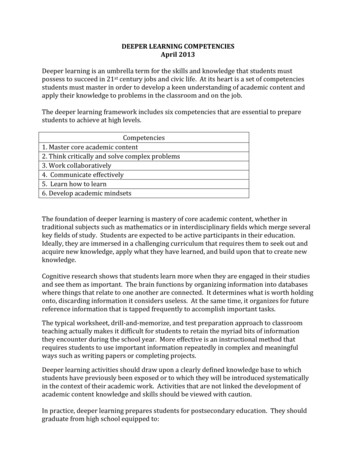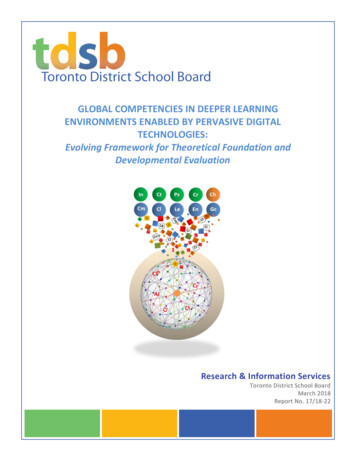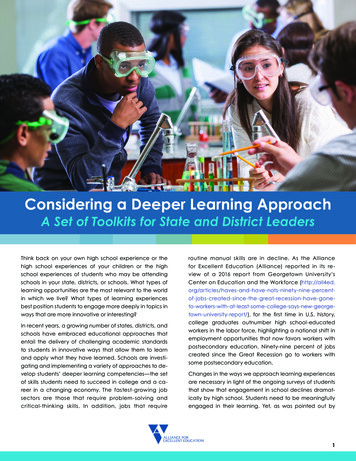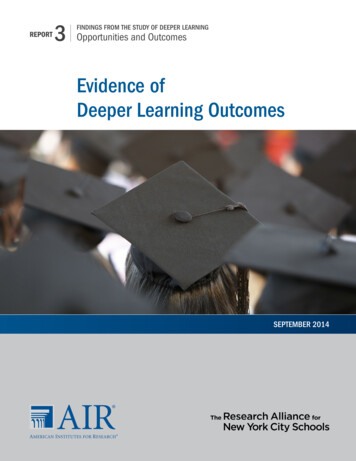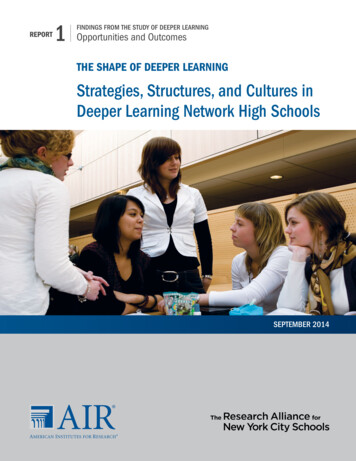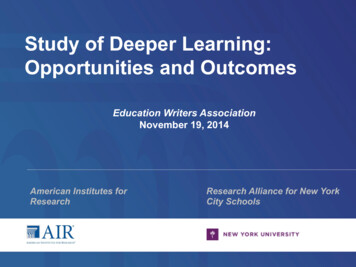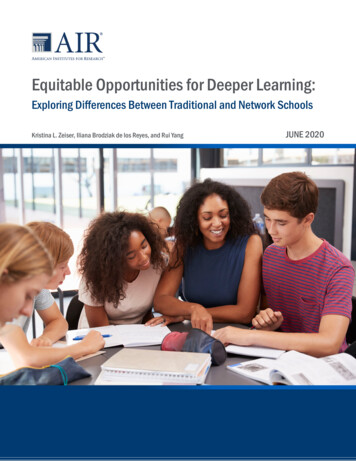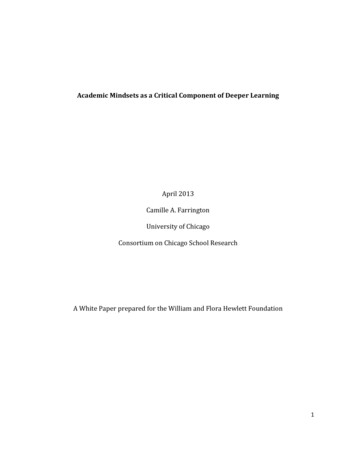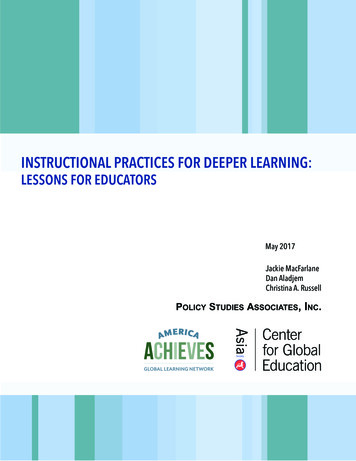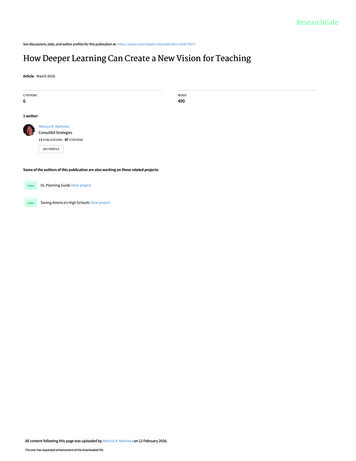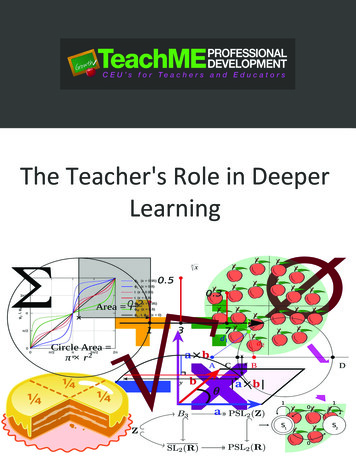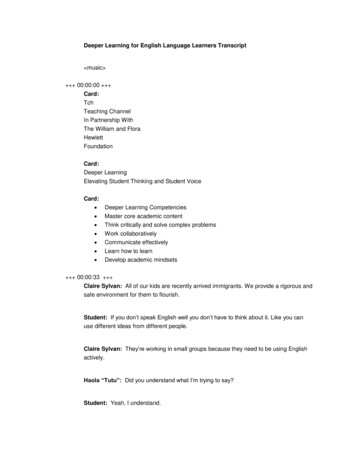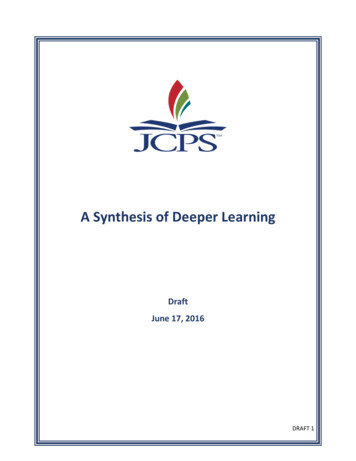
Transcription
A Synthesis of Deeper LearningDraftJune 17, 2016DRAFT 1
Table of ContentsExecutive Summary3Deeper Learning Introduction4Deeper Learning History and Timeline5What is Deeper Learning? Frameworks6What is Deeper Learning? Capacities and Dispositions7What does Deeper Learning Look Like? Strategies and Structures8Characteristics of Authentic Assessment10Assessments of Capacities and Dispositions11Deeper Learning: Impact on Student Outcomes12Deeper Learning: Educator Competencies13Developing Teacher Leaders in Deeper Learning14Deeper Learning: Resources and National Experts15Current JCPS Initiatives Aligned with Deeper Learning16National and Local Exemplars of Deeper Learning17References19AppendixVisuals of Deeper Learning21Alignment with Vision 2020 Strategies23JCPS Proposed Deeper Learning Framework25E-Portfolio and Rubric Example26Conceptual Framework For Teacher Leadership30Benchmark Districts Work on Deeper Learning31JCPS Deeper Learning Committee Members37DRAFT 2
Executive SummaryJefferson County Public Schools (JCPS) is embarking on a mission to transform teaching andlearning by implementing Vision 2020, the district’s newly adopted strategic plan. At the core ofVision 2020 is Deeper Learning, a goal that “each student will progress toward mastery of bothacademic standards and the development of capacities, dispositions necessary for success incollege, career, community, and life.”Deeper Learning- What? Although there is no single consensus on the definition of deeper learning, educationexperts and national research groups generally agree that it refers to a set of capacitiesand dispositions that students need to be successful in not only school, but in life. Thesetypically are centered in the areas of critical-thinking, communication, and working withothers. The deeper learning movement has been largely driven by the postsecondary andlabor/industry sectors that have not been satisfied with the capacities and dispositionsof incoming or potential employees.Deeper Learning- Why? In order to authentically engage students, it is critical that schools provide meaningfullearning experiences to students. When students find meaning in their learningexperiences and are provided a variety of instructional approaches, it increases theirability to retain and utilize the information and skills learned. Traditional learning approaches and standardized testing do not alone support studentlearning and retention of the information learned. In essence, deeper learning is about students’ ability to acquire AND transfer theirknowledge and skills in a variety of settings including in the school, college, and careersectors.Deeper Learning- Who? In order to transform teaching and learning, deeper learning will be all encompassing inworking with students and the community of people they work and interact withincluding teachers and staff, their peers, their families, and their larger community.Deeper Learning- How? Though it is clear deeper learning is important, how to implement and attain it not aneasy task. It involves transforming the learning experiences of students and expandingand supporting teachers as leaders and designers of their students’ educationexperience. Deeper learning in JCPS will involve setting a foundation for learning by teaching socialemotional skills, and supporting a strong climate and culture for educator leadershipand student voice, along with incorporating meaningful real-world learning experiences,frequent opportunities for students to work with their peers, and authenticassessments.DRAFT 3
Deeper Learning IntroductionIn a recent 2016 focus group with JCPS students, they were asked what they liked most aboutschool, and responses included: I like when a teacher teaches us life things like what we need in life How to solve problems, stuff happening in the world and connecting our realworld problems to stuff in school I like when teachers get to know me and help keep me out of troubleWhen asked what they feel they like least about schools, responses included: Some teachers make school boring In science, we don’t do any projects, just writing Our class is so quiet, we never talk Our teachers don’t want to get to know me, just want to get their work doneWhat these quotes illustrate is students voicing their need to connect to schools, teachers, andtheir own learning. Deeper learning is about strengthening the ability of our schools to makelearning meaningful to students so that they feel embraced, empowered, and engaged. Thedegree to which learning experiences are personalized is key to this transformation so that 1)education is tailored to students’ needs, skills, and interests, 2) multiple types of instructionalexperiences are provided to help enrich the learning experience so students are prepared forthe complexities they encounter in college and career, and 3) students take increasingownership and involvement in their own learning growth and trajectories.With the introduction and passage of the Every Student Succeeds Act (ESSA), the federalconditions to support deeper learning are increasing. ESSA allows more flexibility for states tobase student learning on multiple measures, as well as providing grants to support innovativepilots in assessments nationwide. Though the specific implications of ESSA for the state ofKentucky have not yet been determined, the emphasis on moving beyond a high-stakesaccountability system is promising.This literature synthesis serves as a starting point for JCPS to begin the work of transformingteaching and learning through deeper learning. Many excellent large-scare literature reviewsare available as indicated in the references section, and many experienced organizations areavailable for consultation as indicated in the resources section. Therefore, this paper does notserve as a comprehensive, detailed meta-analysis of all the intricacies of deeper learning.Instead, the structure of this paper is to provide short overviews and summaries of major areaswithin deeper learning, including the history, definitions and frameworks, research,assessments, and national and local exemplars. It also provides a draft of a possible JCPSDeeper Learning Framework centered around the areas of Thinking, Communicating, andCaring. This structure allows some flexibility in how this synthesis paper can be used as both aquick reference guide on specific topics, as well as an overview on many relevant areas JCPSleaders need to be considering during the planning and implementation phase of DeeperLearning.DRAFT 4
Deeper Learning: TimelineBelow is an abbreviated timeline that highlights major contributions in this field as well as JCPSconnections:1997: The New York Performance Standards Consortium representing 28 high schools formedwith the goal of creating learning conditions that focused on fostering deeper learning skills viaproject-based curricula, and student performance based assessments with external evaluatorsfor written and oral student work.2002: The Partnership for 21st Century Skills (P21), a national organization that advocates for21st century readiness for every student, produced a guide called “The Leader’s Guide to 21stCentury Education” which described how to provide students with transferable skills anddeeper knowledge for the future.2009: The Center for Public Education (CPE) described how the technological revolution hasprofoundly changed the types of skills needed in the workforce over the last 30 years with“routine” tasks decreasing and “higher level skills and complex communication” increasing.2010: The “deeper learning” term was coined in areport by the William and Flora Hewlett Foundation.They funded a longitudinal study of 20 high schoolswhich implemented a deeper learning experience forstudents.Deeper learning refers to “a set ofcompetencies students must master in order todevelop a keen understanding of academiccontent and apply their knowledge to problemsin the classroom and on the job.”-Hewlett Foundation (2010)2012: The National Research Council convened acommittee to more clearly define 21st century skills (orcompetencies) and they organized the skills into three broad domains: cognitive, intrapersonal,and interpersonal.2012: Longitudinal study of the schools from the New York Performance Standards Consortiumreleased finding that students in Consortium schools outperformed comparison students ingraduation and college-going and college persistence data, and showed significantly fewerdiscipline issues.2014: American Institutes for Research releases the findings of the Hewlett funded study andfound deeper learning schools outperformed comparison schools on higher order problemsolving tests, stronger interpersonal and intrapersonal outcomes, higher graduation rates, andhigher likelihood of enrolling in four-year postsecondary institutions.2014: JCPS Next Generation Learning Summit is held in Louisville, KY with various stakeholdersincluding students, teachers, district staff, and community partners to discuss capacities anddispositions of successful next generation learners.2016: JCPS launches Vision 2020 with Deeper Learning adopted as the core approach toimprove student learning.DRAFT 5
What is Deeper Learning? : FrameworksThe chart below depicts various ways deeper learning dispositions and capacities have beendescribed. Most current literature of deeper learning describe the dispositions and capacitieswithin three primary domains: Cognitive, Interpersonal, and Intrapersonal. The 4Cs from 21 stCentury Skills were precursors to the deeper learning work developed by the HewlettFoundation, and were comprised of primarily the Cognitive and Communication domains. Astechnological advances grew in the 21st century, the importance of the Intrapersonal domainhas grown in deeper learning models as a key aspect of student growth and success.21st CenturySkills (4Cs)2002Critical thinkingand HewlettFoundation2010CognitiveDomain:Deeper contentknowledgeCritical thinkingand complexproblem ionIntrapersonalDomain:Understandinghow to learnAcademicmindsetsNational Research Council2012Cognitive Domain:Cognitive processes andstrategiesKnowledgeCreativityCompetencies: Criticalthinking, reasoning,information literacy,innovationInterpersonal :Communication,responsibility, conflictresolutionIntrapersonal Domain:Intellectual opennessWork ethic andconscientiousnessPositive core self-evaluationCompetencies: Metacognition, flexibility,appreciation for diversity,initiativeNext Generation LearningSummit2014Think including but notlimited Communicate including butnot limited to:ReadingNumeracyListeningSpeakingWritingCare including but notlimited lityPerseveranceGrit/ResilienceThe Next Generation Learning Summit held in Louisville convened community and schoolrepresentatives to discuss the capacities and dispositions needed for students to be successfulin life and described it within 3 broad categories: Thinking- the power to think critically,creatively, and productively, Communicating- the power to interpret, express, and influence,and Caring- the power to relate constructively to self and others. The JCPS Deeper LearningPlanning Committee recommends this language as the framework for future work (seeappendix).DRAFT 6
What is Deeper Learning? : Dispositions and CapacitiesCapacities refer to “actual or potential abilities”, while dispositions refer to the “predominantor prevailing tendency of one’s spirits.” Essentially, dispositions may be described as qualitiesrelating to temperament or personality, while capacities references the potential abilities oractions associated with an individual. These terms are often used interchangeably. Possiblefocal areas of dispositions and capacities related to Deeper Learning could include (but are notlimited to) the following:Capacities and Dispositions under Think, Communicate, Care Framework(Note: Definitions are for illustrative purposes and may be revised as JCPS Deeper Learningwork continues) Respect: a feeling or understanding that someone or something is important, serious,etc., and should be treated in an appropriate way Responsibility: able to be trusted to do what is right or to do the things that are expectedor required Empathy: the action of understanding, being aware of, being sensitive to, and vicariouslyexperiencing the feelings, thoughts, and experience of another Compassion: sympathetic consciousness of others' distress together with a desire toalleviate it Inclusivity: including people who might otherwise be excluded or marginalized Stewardship: the activity or job of protecting and being responsible for something Perseverance: the quality that allows someone to continue trying to do something eventhough it is difficult Resilience: an ability to recover from or adjust easily to misfortune or change Grit: mental toughness and courage Adaptability: able to change or be changed in order to fit or work better in some situation or forsome purpose Creativity: the ability to make new things or think of new ideasInnovative: having new ideas about how something can be doneCuriosity: desire to knowProblem-Solving: the process of finding solutions to difficult or complex issues.Critical Thinking: the objective analysis and evaluation of an issue in order to form ajudgment.Analytical Thinking: separating something into component parts or constituent elementsCollaboration: to work with another person or group in order to achieve or do somethingNegotiation: a formal discussion between people who are trying to reach an agreementVoice: wish, choice, or opinion openly or formally expressedReflection: thinking carefully about somethingMindfulness: the practice of maintaining a nonjudgmental state of heightened orcomplete awareness of one's thoughts, emotions, or experiences on a moment-tomoment basisSelf-Regulation: ability to monitor and control our own behavior, emotions, or thoughts,altering them in accordance with the demands of the situationDRAFT 7
What Does Deeper Learning Look Like? : Strategies and StructuresPersonalized school culture supporting social-emotional learning (SEL): A supportive, engagingculture is the foundation of the student learning experience. In order to help students developsocially, emotionally, and intellectually, schools must intentionally provide learningopportunities in a safe and caring community of learners. Building these experiences into thestructure, organization, and instructional core of the school provides the foundation thatenables children to become successful lifelong learnersProject-based learning: Central to the deeper learning network schools, project-based learningare often student-driven projects that incorporate industry standards-based assessments, andoften result in exhibitions of student work. Projects can range from independent short-termprojects, to in-depth studies of an area for several weeks to a year. By applying multiple areasof knowledge to engaging projects, students are required to critically think and problem solvewhile taking risks and persevering through challenging work. Project-based learning is a centralstrategy in transforming teaching and learning in the JCPS Ford NGL Master Plan.Collaborative group work: Frequent opportunities for students to connect with and work withtheir peers fosters students’ respect for the contributions of others, communication skills, andconflict resolution skills.Flexible learning environments: Resources including staff, space, and time are flexible tosupport a personalized school culture. Aspects of the environment may be altered to enhancethe implementation of personalized learning. Schedules and groupings may be changed toprovide higher responsiveness to student needs, including regrouping based on data andassessment. Flexible learning environments have been enhanced by rapid technologicaladvances, which allow for platforms and digital content to be personalized to student needs.Furthermore, students are able to make choices about the content and structure of learningbecause the school provides a variety of instructional approaches. There are opportunities forremediation and personal support as well as enrichment. Out-of-school opportunities involvingreal-world meaningful experiences are also provided to support student engagement andlearning.Learner profiles: In order to understand and deepen understanding of students, a profile maybe developed of each student that delineates their strengths and motivations, tracks progress,and helps to set goals to improve learning and growth. Teachers and students work together todevelop these profiles that typically use multiple sources of data such as projects, tests,presentations, and software performance to provide a richer, more detailed understanding ofeach student’s needs.Competency-based progression: In contrast to traditional progression schedules, deeper,personalized learning allows for students to advance at their own pace and earn credit when anadequate level of competency has been demonstrated. Assessments of competency may utilizemultiple sources including project-based activities to traditional tests.DRAFT 8
Emphasis on college and career readiness: As noted earlier, deeper learning was largely drivenby the needs of the business and labor sector demanding a workforce with higher level skillssuch as problem-solving, critical thinking, creativity, and an ability to work collaboratively.Schools with a deeper learning emphasis typically have focused activities around the area ofdeveloping college and career readiness, including activities such as college visits, careersurveys, career-based internships, provision of college-level courses, and supporting a collegegoing culture.Authentic assessment: Deeper learning requires authentic, thoughtful, personalizedassessments that are competency based and provide multiple opportunities for students todemonstrate, communicate, and refine their own learning. Assessments in a deeper learningschool moves away from traditional multiple choice tests towards meaningful world-connectedassessments such as demonstrations and portfolios (see below).(Conley & Darling-Hammond, 2013)DRAFT 9
Characteristics of Authentic AssessmentThe table below is outlined from Wiggin’s classic (1998) authentic assessment paperdistinguishing the difference between traditional assessments and authentic assessments. Thetable below illustrates key differences between them.Typical testsRequire correct responsesAuthentic tasksRequire a high-quality productor performance, and ajustification of the solutions toproblems encounteredMust be unknown to theShould be known in advance tostudent in advance to be valid students as much as possibleIndicators of authenticityCorrectness is not the onlycriterion; students must beable to justify their answers.The tasks and standards forjudgment should be known orpredictable.Are disconnected from real- Are tied to real-world contexts The context and constraints ofworld contexts and constraints and constraints; require thethe task are like thosestudent to “do” the subject.encountered by practitionersin the discipline.Contain items that isolateAre integrated challenges inThe task is multifaceted andparticular skills or factswhich a range of skills andcomplex, even if there is aknowledge must be used inright answer.coordinationInclude easily scored itemsInvolve complex tasks that for The validity of the assessmentwhich there may be no rightis not sacrificed in favor ofanswer, and that may not bereliable scoring.easily scoredAre “one shot”; students get Are iterative; contain recurring Students may use particularone chance to show theirtasksknowledge or skills in severa
Deeper Learning: Educator Competencies 13 Developing Teacher Leaders in Deeper Learning 14 Deeper Learning: Resources and National Experts 15 Current JCPS Initiatives Aligned with Deeper Learning 16 National and Loc
